Red foxes, Vulpes vulpes, have reached and established a breeding population on the remote and uninhabited St. Matthew Islands in the northern Bering Sea in association with climate warming in recent decades (Figure 1) (Matsuoka 2003; Post 2009) and are suppressing native arctic foxes (Alopex lagopus). The St. Matthew Islands, part of the Alaska Maritime National Wildlife Refuge, are the most remote lands in the United States (Klein et al. 2015). They support over a million colonial-nesting sea birds (Figure 2), as well as ground-nesting bird species, including the endemic McKay’s bunting (Plectrophenax hyperboreus) (Figure 3) and a major portion of the total breeding population of Pribilof rock sandpipers (Erolia ptilocnemispiolosemis) (Ruthrauff et al.2012) (Figure 4). During a Refuge expedition to the islands in summer 2005 we observed that red foxes (Figure 5), presumably having arrived over the sea ice, which is seasonally present there (Luchin et al. 2002), were suppressing the native arctic foxes (Figure6) on St. Matthew Island.
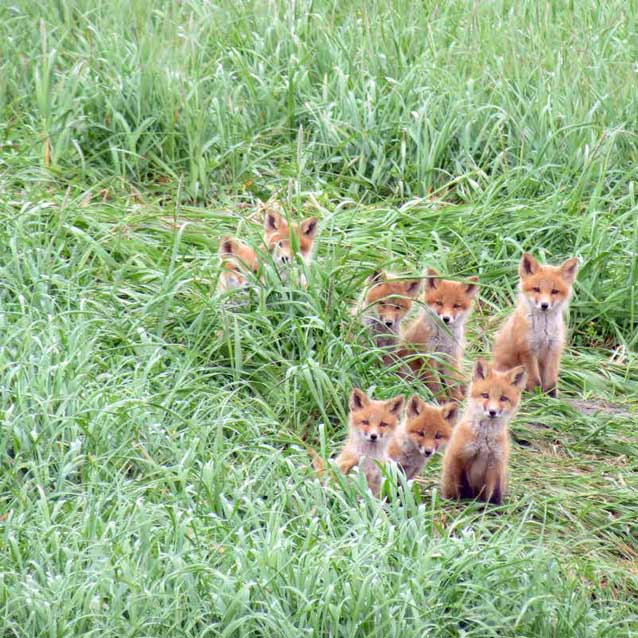
D. Klein
On another visit to these islands in 2012 (July 29 to August 8) we found red foxes abundant and with large litters of young on St. Matthew Island (Figure 7), the largest island in the three-island group. No arctic foxes appeared to be remaining there, whereas on adjacent Hall Island only arctic foxes were observed to be present. In addition to the two fox species, the only other land mammal native to the St. Matthew Islands is an endemic singing vole (Microtus abbreviatus) (Figure 8), and it was presumably a primary prey species, along with colonial-nesting sea birds, of both fox species in the summers of 2005 and 2012 when vole population levels on both St. Matthew and Hall islands were moderately high. Neither voles nor foxes are resident on Pinnacle Island (Figure 9) which is composed of marine hardened volcanic rocks and lacks lowland tundra habitat of importance for voles and denning foxes (Klein et al. 2015).
Complex questions for conservation of life forms within island ecosystems are posed by arrival of a new mammal species to the St. Matthew Islands. How do red and arctic foxes differ in their predatory behavior and what are the consequences for colonial-nesting sea birds, ground-nesting land birds, and the endemic vole?
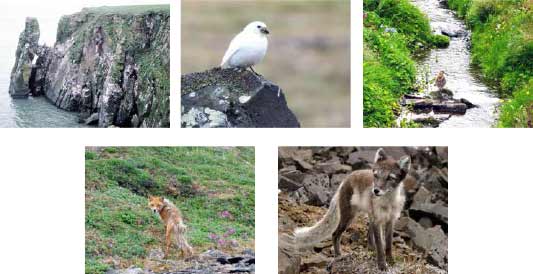
D. Klein
Adaptability of the Foxes to a High-Latitude Maritime Environment
Natural distribution of the arctic fox throughout the coastal regions of the circumpolar Arctic is consistent with the species’ evolutionary adaptations for life under the extreme seasonal variability that characterizes its wide distribution (Bancroft 1886; Audubon et al. 1967; Wilson and Ruff 1999). On St. Matthew and Hall islands, surrounded by sea ice for about five months during winter and where there is wide intra-annual variation in food abundance and availability, arctic foxes appear well adapted to the northern maritime coastal environment (Audubon et al. 1967; Wilson and Ruff 1999).
This is borne out by the arctic fox’s continued historical presence on the St. Matthew Islands, as noted by early explorers and others visiting these islands (Elliott 1875; Merriam 1901-1910; Hanna 1920; Klein 1959, 1968, 1987, 2009). In 1997 red foxes were first observed to be breeding there (Matsuoka 2003), although a single red fox was observed there in 1966 (Klein). The red fox in North America has roots of evolutionary adaption to the boreal forest environment (Wells 2011). Differences in the feeding strategies, predatory behavior, and prey selection of arctic versus red foxes presumably are a product of the environmental influences within the biomes in which these two fox species evolved and currently exist.

I. Jones
Changing Predator Prey Relations
Weighing consequences of predation by arctic versus red foxes on nesting birds and the singing vole of the St. Matthew Islands is aided by Olaus J. Murie’s investigations in the late 1930s in the Aleutian Islands that border the Bering Sea on the south (Murie 1959). In 57 red fox scats from Dolgoi Island examined by Murie, small mammals (mostly Microtus spp.) predominated over birds (52 percent versus 22 percent) among items identified. Other food remains present in the droppings included sand fleas (Orchestia traskiana and other amphipods), sea urchins (Strongylocentrotus spp.), mussels (Mytilus spp.), small fish, and hair seals (Phoca spp.). In a similar comparison of 25 red fox droppings from Unalaska Island, where a greater diversity of small mammal species were available (Citellus spp., Microtus spp., Dicrostonyx spp.), as well as greater numbers and species diversity of colonial nesting sea birds, small mammals again predominated over birds (82 percent versus 18 percent) among the identified items. Murie observed that when present on larger islands red foxes spent more time foraging inland than at the coast whereas the reverse was true of arctic foxes.
He also observed that arctic foxes readily swam while foraging for food when preying on birds in contrast to the general reluctance of red foxes to swim. To add emphasis, he noted (page 303) that Aleuts had described to him how “On occasion…a fox will stand on a point of rock where ducks are diving and, when a duck is rising in the water nearby, the fox will jump in and seize it while it is still below the surface.” He further observed that arctic foxes readily swim from one island to another when the distance is not great. The aversion to swimming by the red fox may partially account for the failure as yet of the red fox to cross three-mile-wide Sarichef Strait that separates St. Matthew and Hall islands (Figure 1) in sufficient numbers to establish a breeding population on the latter island. Strong currents in the strait, which generate more turbulent seas than in the surrounding waters, would be a further deterrent to swimming. And the strong currents through the strait and increased wind velocities in winter would presumably account for highly fractured, rougher, and moving sea ice, which would discourage winter crossings.
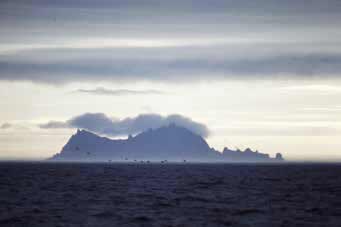
D. Klein
Comparing Predation by Arctic versus Red Foxes on Fauna of the St. Matthew Islands
Nest site preferences of colonial-nesting sea birds vary by species among cliff ledges, rock crevices, the soil surface, or earthen burrows and this necessarily is a factor governing the degree of influence of fox predation on bird population dynamics. Fulmars prefer nesting on the ground surface but can only do so where foxes cannot reach their nests (Figure 10). Assumed predation effects of the red fox in comparison to the arctic fox on bird species nesting on the St. Matthew Islands based on our observations there and relevant publications on the two fox species is graphically modeled in Figure 11. Waterfowl and shore birds are typically ground-surface nesters in similar arctic and subarctic habitats. St. Matthew passerine species include typical ground-surface nesters such as Lapland longspurs (Calcarius lapponicus), as well as those that are variable in nest site selection between the ground and crevices, including McKay’s bunting (Figure 3), and rosy finches (Leucosticte tephrocotis). Unlike birds, other vertebrate species present on the St. Matthew Islands—the singing vole and fish—are resident throughout the year. The voles, at least, can be expected to play a greater role as prey of foxes when birds are absent from the islands. The singing vole most likely has been of primary importance as a food source for both red and arctic foxes during winter in past years on the St. Matthew Islands when vole numbers were at high levels in their population cycles (Figures 12a and 12b).
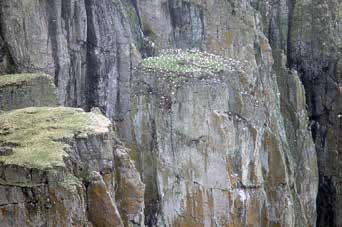
D. Klein
This was apparently the case in the severe winter of 2011-2012 in the eastern Bering Sea region (Alaska Climate Research Center 2012), when sea ice was present longer in the eastern Bering Sea region and extended further south, as observed by residents of both St. Paul and St. George islands, than has been the case in past decades (Shulski and Wendler 2007). During our presence on the islands in summer 2012, it was apparent that high vole numbers had coincided with the previous severe winter on the St. Matthew Islands as evidenced by the remains of winter vole runways and their nests remaining on the tundra surface after the snow had melted. Additionally we found voles to be relatively abundant during summer in 2012.
Differences in body morphology of arctic and red foxes, most notably the longer legs and larger body mass of red foxes, results in a higher center of gravity that renders red foxes substantially less efficient climbers on the coastal cliffs than arctic foxes (MacDonald and Cook 2009). On St. Matthew Island, predation on birds, the eggs, and young of those nesting on the coastal cliffs (Figure 13) can therefore be expected to be considerably less with only red foxes present in contrast to the past when only arctic foxes were there (Klein 1959). By contrast, the crevice-nesting small auklets (Figure 14) usually occur in large numbers and high density in large boulder-field colonies. Foxes primarily prey on adult and fledging young auklets when synchronously emerging from nest cavities to socialize on the surface above before leaving for and returning from their daily flights to forage at sea. Predation by both fox species at auklet colonies is substantial even though most nesting cavities are relatively secure from being dug into by the foxes. Predation impact of either fox species on auklet colonies is expected to be closely tied to the relative density of the foxes.

D. Klein
Density of foxes is also important in assessing effects on nesting success of ground nesting birds by red foxes on St. Matthew versus arctic foxes on Hall Island. On northern St. Matthew Island, where two auklet colonies offered perhaps the most abundant bird prey available to the foxes, we found only two active red fox dens with young in 2005 and these same dens were similarly used by the red foxes in 2012 (Figure 15). The dens were about 2.4 miles (4 kilometers) apart, adjacent to the Bering Sea coast, but on opposite sides of the island. Each den was sited about .9 miles (1.5 kilometers) from one of the two auklet colonies on the northern portion of St. Matthew Island. The adult foxes from each den presumably exercised some control over access to the proximate colony by other foxes.
Arctic fox maternal dens on St. Matthew Island in the past, before the arrival of the red foxes, were frequently found at the edges of auklet colonies and with dens often within .6 miles (1 kilometer) of one another, which has been the pattern observed on Hall Island. On the much larger St. Lawrence Island about 186 miles (about 300 kilometers) to the north, Stevenson (1970), in a study of summer food habits of the arctic fox, found that active and presumably maternal arctic fox dens in areas of high prey availability were generally separated by .6 to .9 miles (1 to 1.5 kilometers).
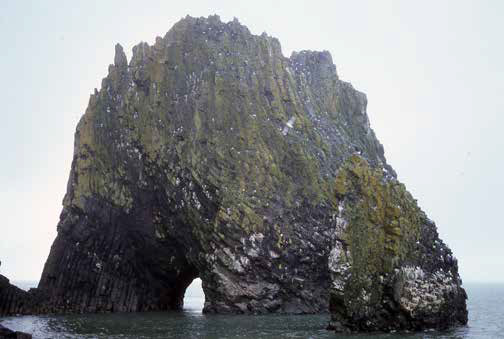
R. Kleinleder
Both fox species, however, must contend with high variation seasonally in prey availability, abundance, and importance of other food types, inclusive of marine invertebrates, and carcasses of fish and marine mammals that are washed onto the beaches by wave action. The latter food resource however, may not be refreshed when shore-fast ice is present during the four to five months of winter during which the St. Matthew Islands are surrounded by the Bering Sea ice pack. On the St. Matthew Islands birds and their eggs are only directly available as a potential food source for the foxes through predation during the short summer period of nesting and rearing of young. Foxes of both species however, do cache food for possible future use (Stevenson 1970; Fay and Stevenson 1989; Wilson and Ruff 1999).
Population numbers of the singing vole have varied widely in the past on a cycle of three to five years as has been common among other small rodents at high latitudes (Smith 2008). On the St. Matthew Islands voles are active under the snow cover in winter, as is evident when melting snow exposes winter nests and runways, as are other voles at northern latitudes (Pruitt 1978). Red foxes, because of larger body size, longer legs, and behavioral adaptations for hunting small mammals under snow and vegetative cover, are presumably somewhat better adapted than arctic foxes for preying on voles in winter on the St. Matthew Islands (Henry 1996).
Small rodents however, made up a large portion of the winter diet of arctic foxes on St. Lawrence Island, 186 miles (300 kilometers) to the north in the absence of red foxes (Stevenson 1970; Fay and Stevenson 1989). Small mammal prey diversity for foxes is considerably greater on St. Lawrence Island than on the St. Matthew Islands. In alpine habitats in the Scandinavian Arctic, another study found that the lemming (Dicrostonyx groenlandicus), a typical arctic alpine species, made up 80 percent and voles 20 percent of the prey items in scats of arctic foxes (Frafjord 1995). Red foxes at the time favored lowland habitats where they preyed exclusively on voles. On the St. Matthew Islands, both fox species have been observed in the past preying significantly on voles when their numbers were high on both St. Matthew and Hall islands.
In 2005 when our base camp on St. Matthew was located 328 feet (100 meters) from a red fox den with eight young, we observed adult foxes returning to the den with food for the young foxes. These foxes were generally consistent in carrying either voles or least auklets hanging from their mouths. This pattern of prey selection coincided with the direction in which each adult fox had set out from the den to begin its foraging bout: the direction being inland when a fox later returned with voles, and north along the shore when returning with only auklets, presumably secured from the auklet colony that was about a mile north of our camp. Although our observations were made opportunistically as we carried out camp activities, we estimated that about equal amounts of biomass of voles and auklets were returned to the den during our observations.
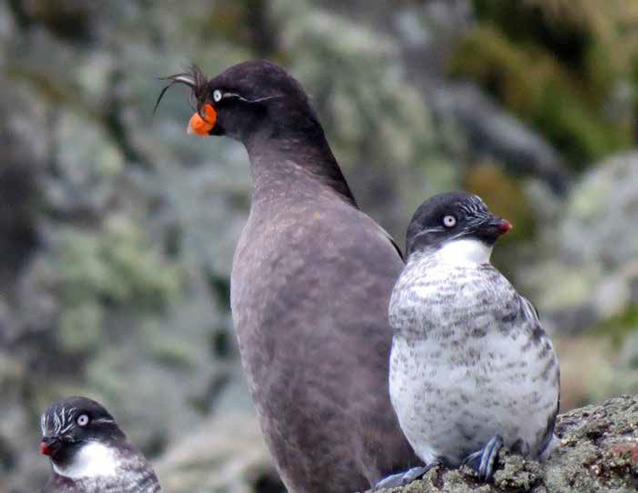
R. Kleinleder
Overwintering a Bottleneck for Fox Survival on the St. Matthew Islands
DNA analyses suggest that the arctic fox evolved in the maritime coastal environment of the North American arctic and subarctic where sea ice was present at least seasonally (Henry 1996). Red foxes, Eurasian in origin, first entered North America in the Illinoian glaciation with subsequent mixing of North American and Eurasian clades in Beringia during the Wisconsin glaciation (Heptner and Naumov 1998). During the Holocene, mixing with the North American boreal clade continued (Aubry et al. 2009). Though specialized for the northern boreal rather than the arctic environment, the red fox is highly adaptable to environmental change and is considered among the animals of least concern for extinction by the International Union for the Conservation of Nature (2008). This is a valid assessment in view of the global distribution of the red fox and its history of success in adapting to human-altered environments. When viewed at the population level on a remote maritime island with an arctic climate in winter however, there are qualifying constraints that may limit sustainability of the St. Matthew red fox population. The history of the demise of the St. Matthew reindeer brought about by extreme winter weather in 1964 points out the vulnerability of the more recently established red fox population in view of the increased likelihood of extreme weather events anticipated with continuing global climate change (Klein et al. 2009). These include low likelihood of red fox dispersal via the sea in contrast to the arctic fox to relieve population pressure during periods of seasonal food limitation. Conversely there is limited potential for increasing the gene pool of the present population most likely founded by a single pair of foxes that were able to reach the island via seasonal sea ice in the northern Bering Sea. Low genetic diversity may contribute to lowered resistance to certain diseases in semi-isolated populations (Geffen et al. 2007). This is a likely risk factor for the red foxes on St. Matthew Island where diseases, such as rabies, may be brought to the island by other foxes reaching the island in the future (Rausch 1958).
In a comprehensive study of interspecific competition and geographical distribution of red and arctic foxes by Hersteinsson and Macdonald (1992) that included consideration of interference competition, cold tolerance, body size, and related energetics, and climate change influences on habitat, they concluded that “the northern limit of the red fox’s geographic range is determined directly by resource (food) availability (and thus ultimately by climate), whereas the southern limit of the distribution of the arctic fox’s range is determined, through interspecific competition, by the distribution and abundance of the red fox.”
Recent reports of displacement of arctic foxes by red foxes appearing in both the public and scientific media often emphasize correlation with climate change without explaining the climate-driven and often complex cause and effect relationships within intertrophic level processes (Ims and Fuglei 2005; Post et al. 2009). In the Bering Sea coastal areas of Alaska’s Yukon Delta, increasing numbers of red foxes as well as arctic foxes in recent decades, although correlated with declining nesting success of black brant and climate warming, appears to have been more directly tied to increased numbers of microtine rodents, an important food source for both fox species during winter. The increase in rodents was a direct product of climate-induced improvement of habitat conditions for the rodents through lengthening of the summer period for plant growth and rodent reproduction (Anthony et al. 1991). The decrease in black brant nesting success in this case was found to be tied to increased nest predation by arctic foxes that prefer wetter sedge-dominated coastal marshes where brant nesting is concentrated. Red foxes at the time however, were at high density in the adjacent slightly higher and drier, low-shrub tundra during summer where small rodents continued to be their major prey component (Feldhamer et al. 2003).
A study in northern Norway concluded that competition between red and arctic foxes had been more important than changes in prey dynamics associated with climate change in accounting for the failure of arctic foxes to recolonize (Hamel et al. 2013). We suggest that it has been the mediating climate in recent decades on St. Matthew Island, allowing for increased and extended seasonal vascular plant growth that has enabled vole populations to remain at moderately high levels interannually (Klein and Shulski 2009), rather than cycling between low and high population numbers as appeared to have been the case among microtine vole populations throughout the Arctic (Ims and Fuglei 2005), thus enabling red foxes to establish and maintain a population there.
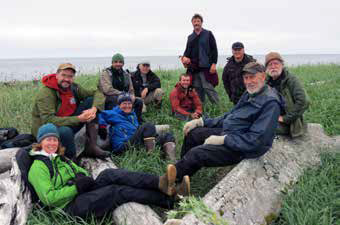
R. Kleinleder
Conclusions
Multiple factors are involved in assessing the nature and magnitude of ecosystem change on St. Matthew Island since displacement of arctic foxes by red foxes. On St. Matthew Island in the presence of only red foxes:
- Cliff-nesting birds should experience considerably less predation than when the arctic fox, more adept at climbing, was the only fox species present.
- Predation selection for crevice-nesting birds, primarily the small auklets, although about equal by the two fox species, should be less in the presence of red foxes because of their larger home ranges, more strongly defended maternal den territories leading to presumed ultimate lower population density than was the case in the past when only arctic foxes were there.
- Ground-nesting birds may suffer less predation under an expected lower red fox density on St. Matthew Island, with the following constraints: a somewhat higher predation rate by individual red foxes as a function of their larger body size; when singing vole numbers are low, red foxes may focus more on ground-nesting birds than arctic foxes have in the past, especially when their home ranges do not include auklet colonies.
- On the basis of pronounced differences in intraspecies tolerance of the two fox species and poorer adaptability of the red fox for over-winter survival on St. Matthew Island, which is surrounded by sea ice in winter, red fox density will likely remain considerably lower there than would have been the case if only arctic foxes were present.
- The endemic bird MacKay’s bunting, because of its presence and abundance over the entire island and use of diverse and predominately secure crevice-nesting habitats should be little affected by the shift from arctic to red foxes on St. Matthew Island.
- The singing vole, also endemic to the St. Matthew Islands, can be an important food item for both fox species when in the high phase of their population cycles, especially in winter when other food is limited. Whereas voles appear adapted to sustain high fox preda-tion at the peak of their population cycles, they are protected from significant predation at the low of their cycles by their relative scarcity. In winter, areas where snow is drifted and wind-packed also provide some protection for the subnivian voles from fox predation.
The above assessment of consequences of the presence of red versus arctic foxes on the vertebrate fauna of St. Matthew Island focuses on relative numbers of prey species removed through predation. Possible benefits of species-specific predation that may accrue to the genome of prey species on the St. Matthew Islands through selective removal of less fit individuals (Gilg and Yoccoz 2010) will remain for future assessment of this naturally occurring exchange of predator species.
We propose that the stronger territoriality and larger home range size of the red fox will limit fox population density on St. Matthew Island in contrast to its predecessor the arctic fox that is known to be more tolerant of high population density (Murie 1959; Wilson and Ruff 1999). Our analysis in the absence of a sufficient time line to measure the actual consequences for nesting bird species resulting from a change in the major predator species suggests little likely overall change from the past in the impact of fox predation on populations of nesting birds on the St Matthew Islands. Assessing such consequences for bird populations on the St. Matthew Islands in the future will be constrained by the difficulty in distinguishing between concurrent influences of climate change in both the terrestrial and adjacent marine ecosystems where colonial sea birds seek food during nesting and spend their non-nesting portion of the year. Additionally, present understanding is inadequate for assessing the impact of the Bering Sea commercial fisheries on sea bird populations.
Acknowledgements
Assistance in the field recording observations of foxes and their natal dens during 2005 was provided by Karin Holser, Ian Jones, Max Malavanski Jr., Anne Morkill, Evie Whitten, Randy Hagenstein, Mike Boylan, and Sasha Kitaysky; and in 2012 by Marc Romano, Aaron Poe, Marianne Alpin, Tony Degange, Steve Delehanty, Rich Kleinleder, Ned Rozell, Dennis Griffin, Casey Bickford, Derek Sikes, and Monte Garroute. We appreciate the logistic and field support provided by the Alaska Maritime National Wildlife Refuge in 2005 and 2012 and the safe transport to the St. Matthew Islands and skilled support in the field provided by the crew of the M/V Tiglax. Douglas Burn provided access to available satellite imagery through the Aleutian and Bering Sea Island Landscape Conservation Cooperative (ABSILCC), which has aided in several aspects of the 2012 St. Matthew expedition. We appreciate manuscript review and constructive comments provided by Ned Rozell, Rich Kleinleder, and Marc Romano. Assistance provided by Dan Mann in interpreting land form morphology from 1948 Navy aerial photography aided in planning for the 2012 field activity.
References
Alaska Climate Research Center. 2012.
Winter Weather Summary. Alaska Climate Dispatch. Alaska Center for Climate Assessment and Policy (National Oceanic and Atmospheric Administration). Spring 2012:2-7.
Anthony, P., P. Flint, and J. Sedinger. 1991.
Arctic fox removal improves nest success of black brant. Wildlife Society Bulletin 19:176-84.
Aubry, K., B. Statham, J. Mark, B. Sacks, J. Perrines, and S. Wisely. 2009.
Phylogeography of the North American red fox: vicariance in Pleistocene forest refugia. Molecular Ecology 18(12):2668–2686.
Audubon, J., J. Backman, and V. Cahalane. 1967.
The imperial collection of Audubon animals. Ed. V.H. Cahalane. The Quadrupeds of North America. Maple-wood, NJ: Hammond Incorporated.
Bancroft, H. 1886.
History of Alaska 1730-1885. New York: Bancroft.
Elliott, H. 1875.
Polar bears. Harpers Weekly 19(954):1-2.
Fay, F. 1963.
Field trip to St. Matthew Island, July 17-August 7, 1963. Correspondence to Chief, Zoonotic Disease Section, Arctic Health Research Center, Anchorage. September 6, 1963.
Fay, F., and R. Stevenson. 1989.
Annual, seasonal, and habitat-related variation in feeding habits of the arctic fox (Alopex lagopus) on St. Lawrence Island, Bering Sea. Canadian Journal of Zoology 67:1986-1994
Feldhamer, G., B. Thompson, and J. Chapman, eds. 2003.
Wild mammals of North America: Biology, management and conservation. Baltimore: Johns Hopkins University Press.
Frafjord, K. 1995.
Summer food habits of arctic foxes in the alpine region of southern Scandinavia, with a note on sympatric red foxes. Annals Zoologica Fennici 32:111-116.
Geffen, E., S. Waidyaratue, L. Dalén, A. Angerbjörn, C. Vila, P. Hersteinsson, E. Fuglei, P. White, M. Goltsman, C. Kapel, and P. Waune. 2007.
Sea ice occurrence predicts genetic isolation in the arctic fox. Molecular Ecology 16(20):4241-4255.
Gilg, O., and N. Yoccoz. 2010.
Explaining bird migration. Science 327: 276-277.
Hamel, S., S. Killengreen, J. Henden, N. Yoccoz, and R. Ims. 2013.
Disentangling the importance of interspecific competition, food availability, and habitat species occupancy: Recolonization of the endangered Fennoscandian arctic fox. Biological Conservation 160:114-120.
Hanna, G. 1920.
Mammals of the St. Matthew Islands, Bering Sea. Journal of Mammalogy 1:118-122.
Henry, J. 1996.
Foxes: living on the edge. Minocqua, WI: Northword Press, Inc.
Heptner, V., and N. Naumov. 1998.
Sirenia and Carnivora (Sea cows; Wolves and Bears). Mammals of the Soviet Union. Vol.II. Part 1a. Science Publishers, Inc. USA.
Hersteinsson, P., and D. Macdonald. 1992.
Interspecific competition and geographical distribution of the red and arctic foxes Vulpes vulpes and Alopex lagopus. Oikos 64:505-515.
Ims, R., and E. Fuglei. 2005.
Trophic interaction cycles in tundra ecosystems and the impact of climate change. Bioscience 55:311-322.
Intergovernmental Panel on Climate Change (IPCC). 2007.
Climate Change 2007: Impacts, adaptation and vulnerability. Contribution of Working Group II to the Fourth Assessment Report. Eds. S. Solomon, D. Qin, M. Manning, Z. Chen, M. Marquis. K.B. Averyt, M. Tignor, and H.L. Miller. New York: Cambridge University Press.
International Union for the Conservation of Nature (IUCN). 2008.
Red List of Threatened Species. Gland, Switzerland: IUCN.
Klein, D. 1959.
St. Matthew Island Reindeer range study. Special Scientific Report-Wildlife No. 43. Washington D.C.: U.S. Fish and Wildlife Service.
Klein, D. 1968.
The introduction, increase, and crash of reindeer on Saint Matthew Island. Journal of Wildlife Management 32:350-367.
Klein, D. 1987.
Vegetation recovery patterns following overgrazing on St. Matthew Island. Journal of Range Management 90:336-338.
Klein, D., and M. Shulski. 2009.
Lichen recovery following heavy grazing by reindeer delayed by climate warming. Ambio 38:11-16.
Klein, D., J. Walsh, and M. Shulski. 2009.
What killed the reindeer of St. Matthew Island? Weatherwise 62(6): 32-38.
Klein, D., R. Kleinleder, and H. Renner. 2015.
Differential effects of coastal erosion on colonial nesting sea birds on the St. Matthew Islands. Alaska Park Science, 14(1). Anchorage: National Park Service.
Luchin, V., I. Semiletov, and G. Weller. 2002.
Changes in the Bering Sea region: atmosphere—ice—water system in the second half of the twentieth century. Progress in Oceanography 55:23-44.
MacDonald, S., and J. Cook. 2009.
Recent mammals of Alaska. Fairbanks: University of Alaska Press.
Matsuoka, S. 2003.
Observations of Arctic and Red Fox on St. Matthew and Hall Islands. May 26-July 8, 2003. Tony Degange USFWS files, Anchorage AK.
Merriam, C., ed. 1901-1910.
The Harriman Alaska Expedition (the Harriman Alaska Series). Vol. 1-5. New York: Doubleday. Page and Company.
Murie, O. 1959.
Fauna of the Aleutian Islands and Alaska Peninsula. North American Fauna 61:1-364, Washington, D.C.: U.S. Fish and Wildlife Service.
Pruitt, W. 1978.
Boreal ecology. Southhampton, England: Camelot Press Ltd.
Post, E., M. Forchhammer, M. Bret-Harte, T. Callaghan, T. Christtensen, B. Eberling, A. Fox, et al. 2009.
Ecological dynamics across the Arctic associated with recent climate change. Science 325:1355-1358.
Rausch, R. 1958.
Some observations on rabies in Alaska, with special refer-ence to wild Canidae. Journal of Wildlife Management 22:246-260.
Ruthrauff, D., T. Tibbitts, R. Gill Jr., M. Dementyev, and C. Handel. 2012.
Small population size of the Pribilof Rock Sandpiper confirmed through distance-sampling surveys in Alaska. The Condor 114(3):1-8
Shulski, M., and G. Wendler. 2007.
The climate of Alaska. Fairbanks: University of Alaska Press.
Smith, R. 2008.
Interior & Northern Alaska: A natural history. Bothell, WA: Book Publishers Network.
Stevenson, R. 1970.
A study of the summer food habits of the arctic fox on St. Lawrence Island, Alaska. MS thesis. College, Alaska: University of Alaska.
U.S. Fish and Wildlife Service (USFWS). 2005.
http://alaska.fws.gov/mbsp/seabirds/pdf/citations.pdf
Wells, G. 2011.
Tracing the fox family tree: The North American red fox has a diverse ancestry forged during successive ice ages. Science Findings. Issue 132 (April/May). Portland OR: Pacific Northwest Station.
Wilson, R., and S. Ruff. 1999.
The Smithsonian book of North American Mammals. Washington, DC: Smithsonian Institution Press.
Part of a series of articles titled Alaska Park Science - Volume 14 Issue 1: Resource Management in a Changing World.
Last updated: August 14, 2015
